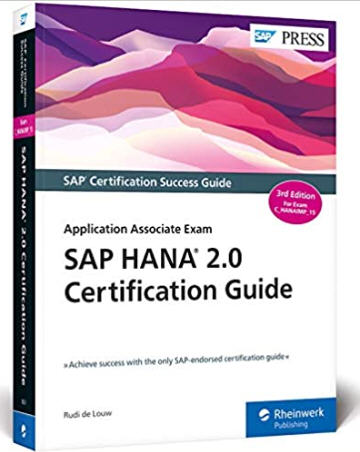Benefits and Specifics of the Product
Preparing for your SAP HANA 2.0 certification?
This guide provides everything you need to ace the SAP Certified Application Associate test for SAP HANA (C_HANAIMP_15)!
Core Content
Walk through the topics covered in the C_HANAIMP_15 exam:
- Information modeling
- Calculation views
- SQLScript
- Security
- And more
Use in-depth questions and answers for each topic to test your knowledge and get a feel for what exam questions will look like.
SAP HANA 2.0
Understand the latest topics added to the test for SAP HANA 2.0, including:
- Core data services (CDS)
- Expanded coverage of spatial, graph, and series data modeling
- Key Topics Covered
- C_HANAIMP_15 exam
- Architecture
- SAP Web IDE for SAP HANA
- Information modeling
- Calculation views
- SQL and SQLScript
- Predictive modeling
- Spatial, graph, and series data modeling
- Security
SAP HANA Certification Track—Overview
Who This Book Is For
SAP HANA Certifications
- Associate-Level Certification
- Specialist-Level Certification
- Exam Objective
- Exam Structure
- Exam Process
SAP HANA Training
- SAP Education Training Courses
- Training Courses for SAP HANA Certifications
Other Sources of Information
- SAP Help
- SAP HANA Home Page and SAP Community
- SAP HANA Academy
- openSAP
- Where to Get an SAP HANA System
- Project Examples
- Where to Get Data
- Types of Questions
- Elimination Technique
- Bookmark Questions
Technology, Architecture, and Deployment Scenarios
Objectives of This Portion of the Test
Key Concepts Refresher
- In-Memory Technology
- Architecture and Approach
- Deployment Scenarios
- SAP HANA in the Cloud
- SAP Analytics Cloud and Business Intelligence
Practice Questions
Practice Question Answers and Explanations
Modeling Tools, Management, and Administration
Objectives of This Portion of the Test
Key Concepts Refresher
- New Modeling Process
- New Architecture for Modeling and Development
- Creating a Project
- Creating SAP HANA Design-Time Objects
- Building and Managing Information Models
- Refactoring
Practice Questions
Practice Question Answers and Explanations
Information Modeling Concepts
Objectives of This Portion of the Test
Key Concepts Refresher
- Tables .
- Views
- Cardinality
- Joins
- Core Data Services Views .
- Cube
- Calculation Views
- Other Modeling Artifacts
- Semantics
- Hierarchies
Practice Questions
Practice Question Answers and Explanations
Calculation Views
Objectives of This Portion of the Test
Key Concepts Refresher
- Data Sources for Calculation Views
- Calculation Views: Dimension, Cube, and Cube with Star Join
- Working with Nodes
- Semantics Node
Practice Questions
Practice Question Answers and Explanations
Modeling Functions
Objectives of This Portion of the Test
Key Concepts Refresher
- Calculated Columns
- Restricted Columns
- Filters
- Variables
- Input Parameters
- Session Variables
- Currency
- Hierarchies
- Hierarchy Functions
Practice Questions
Practice Question Answers and Explanations
SQL and SQLScript
Objectives of This Portion of the Test
Key Concepts Refresher
- SQL
- SQLScript
- Views, Functions, and Procedures
- Catching Up with SAP HANA 2.0
Practice Questions
Practice Question Answers and Explanations
Data Provisioning
Objectives of This Portion of the Test
Key Concepts Refresher
- Concepts
- SAP Data Services
- SAP Landscape Transformation Replication Server
- SAP Replication Server
- SAP HANA Smart Data Access
- SAP HANA Smart Data Integration and SAP HANA Smart Data Quality
- SAP HANA Streaming Analytics
- SQL Anywhere and Remote Data Sync
- Flat Files
- Web Services (OData and REST)
- SAP Vora
- SAP HANA Data Management Suite
Practice Questions
Practice Question Answers and Explanations
Text Processing and Predictive Modeling
Objectives of This Portion of the Test
Key Concepts Refresher
- Text Processing
- Predictive Modeling
Practice Questions
Practice Question Answers and Explanations
Spatial, Graph, and Series Data Modeling
Objectives of This Portion of the Test
Key Concepts Refresher
- Spatial Modeling
- Graph Modeling
- Series Data Modeling
Practice Questions
Practice Question Answers and Explanations
Optimization of Information Models
Objectives of This Portion of the Test
Key Concepts Refresher
- Architecture and Performance
- Redesigned and Optimized Applications
- Effects of Good Performance
- Information Modeling Techniques
- Optimization Tools
- Best Practices for Optimization
Practice Questions
Practice Question Answers and Explanations
Security
Objectives of This Portion of the Test
Key Concepts Refresher
- Usage and Concepts
- SAP HANA XSA and SAP HANA Deployment Infrastructure
- Users
- Roles
- Privileges
- Assigning Roles to Users
- Data Security
Practice Questions
Practice Question Answers and Explanations
Virtual Data Models
Objectives of This Portion of the Test
Key Concepts Refresher
- Reporting in the Transactional Systems
- SAP HANA Live
- SAP S/4HANA Embedded Analytics
Practice Questions
Practice Question Answers and Explanations
| Author's background
and qualifications
Rudi de Louw is the head of the SAP Co-Innovation Lab at SAP in South Africa, where he supports SAP partners in building or improving their business ideas and systems with SAP platforms such as SAP HANA, SAP Cloud Platform, and SAP Leonardo. In this role, he also helps partners extend the integration of their current business products with available and emerging SAP technologies. Rudi has been working with SAP HANA since 2010 and has been involved from the outset in preparing the SAP HANA certification exams. He has provided software and technology solutions to businesses for over 25 years and has a passion for sharing knowledge, mentoring, understanding new technologies, and finding innovative ways to leverage these skills to help individuals in their development. Overall, the SAP HANA 2.0 Certification Guide by Rudi de Louw is an excellent resource for anyone preparing for the SAP HANA Application Associate certification exam. The book provides a comprehensive and practical guide to SAP HANA architecture, data modeling, SQL, administration, application development, analytics, and integration. With its clear explanations, numerous practice questions, and practical tips, the book is a valuable tool for anyone seeking to enhance their knowledge and skills in SAP HANA. |
 |